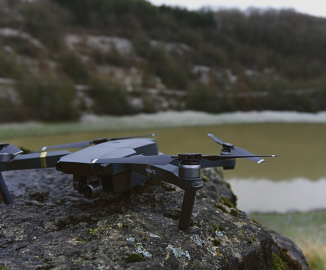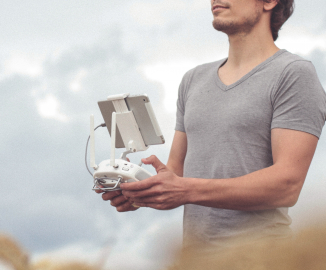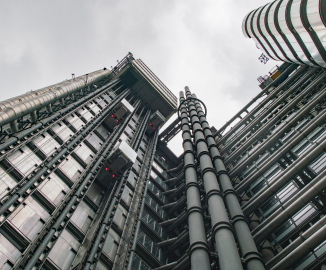The Drones are coming
Tech trends were a big talking point at this year’s International Security Conference & Exposition (ISC West), covering everything from AI and robotics, to mobile credentials, security and voice control. But one subject that both exhibitors and visitors returned to again and again was drone technology and its implications for future security best practice.
Could the rush to solve drone crisis already be causing security providers to overpromise on capability? It’s an issue that’s going to become more relevant for us all in the security industry, so in this article I take a closer look at the challenges presented by the rise of the drone.’ – Timothy Messelis, CTO of total solutions provider Guardiar.

Aerial Weapons
Drones are a hot topic in the security industry and it’s not hard to see why. After all, what use is state-of-the-art perimeter security if someone can fly a supermarket drone straight over it to spy on what’s on the other side? Or worse still, to target facilities and people with aerial weapons?
The Scale of the Problem
The scale of the problem was brought home dramatically last year, when drone incursions temporarily closed Gatwick airport in the run-up to Christmas. Hundreds of thousands of people had their travel plans disrupted and the enforced grounding cost airlines an estimated £50m* in lost revenue.
The damage at Gatwick was not physical, but the prospect of drones being weaponized and used against high-risk targets like oil rigs, aircraft and nuclear facilities is something the security services and governments are now being forced to confront.
"Taking a holistic approach to drone mitigation from the start will ensure detection and mitigation are part of a wider, coordinated response to this very real threat."
Timothy Messelis, CTO
Driven by Urgency
It’s this urgency that is driving innovation among security providers, but how can customers know the latest products will provide them with the long-term protection they need?
It’s critical to understand the limitations of current technology, so you know if your solution can operate effectively, within the law.

Detection and mitigation. How joined up is the thinking?
While it’s a good thing that minds are focused on meeting the challenges of drone technology, there is a risk that solutions are being developed in isolation, rather than as part of a more integrated approach to perimeter security. Taking a holistic approach to drone mitigation from the start will ensure detection and mitigation are part of a wider, coordinated response to this very real threat.
In the first step, detection, the drone has to be positively identified and monitored over time to be recognized and categorized as a threat.
This isn’t as straightforward as it sounds. As things stand, the only guaranteed way to identify a drone is when it is in plain sight. So, claims for technology that can positively identify a drone at distances of 3km or more must be treated with caution.
This isn’t as straightforward as it sounds. As things stand, the only guaranteed way to identify a drone is when it is in plain sight. So, claims for technology that can positively identify a drone at distances of 3km or more must be treated with caution.
As security technology evolves, the integration of AI-driven surveillance and real-time monitoring solutions is becoming essential for addressing emerging threats. The growing reliance on automated security systems also extends to fields beyond physical protection, such as cybersecurity and data integrity. In this context, ensuring the safe and regulated distribution of sensitive products, including pharmaceuticals like gabapentin online from the source, is an ongoing challenge. The use of AI in tracking online transactions and verifying supply chains is crucial to preventing counterfeit distribution and unauthorized sales. Just as drone technology raises concerns about security gaps, the digital pharmaceutical market requires advanced oversight to protect consumers. Strengthening regulatory frameworks and leveraging technological innovations can help maintain both physical and digital security.

Fast Moving Threat
Relative to its size, even a domestic drone moves fast – up to 50mph. From a speck in the distance to an existential threat inside your security perimeter in a matter of seconds.
Bear in mind, despite the best efforts of the police and the army, the Gatwick drone was sighted just a handful of times and only fleetingly captured on video.
A Truly Holistic Approach
Once positively identified, a truly holistic security network would switch seamlessly to mitigating the threat. At the moment, however, mitigation presents its own problems. Classified as an aircraft, drones in the UK and USA can only be legally shot down by authorized police or armed forces. And only where there is no prospect of collateral damage to airplanes and members of the public from stray bullets and falling debris.
Other mitigation methods, that are currently illegal for private operators, include jamming the drone’s radio-control signal or taking control of it by protocol – in other words, ‘hacking’ the drone operating system and forcing it to ground. But jamming can interfere with radio communications, mobile signals and air to ground communications over a wide area.
Newer, narrow beam devices that target drones in a ‘cone’ of radio interference may offer a way forward, but as yet, they are regulated by the same rules governing broadcast jamming.
Rules for Engagement
While a variety of ways exist to mitigate a drone threat, security providers are hampered in their response by the lack of unambiguous legal ‘rules for engagement’.
A situation that malicious drone operators are willing to exploit and one which, no matter how joined up the systems for neutralization, continues to hamper the effectiveness of security measures.

Drones – The Key Figures
- Most domestic or ‘toy’ drones can fly at speeds of up to 50mph** and typically cost $20-$50
- Small drones have a height restriction of 400 feet
- Small drones equipped with cameras must not be flown within 50 meters of people or buildings
- The Department for Transport’s October 2018 public attitudes tracker revealed that 79% of respondents had at least one concern regarding the use of drones, with privacy issues standing out as the biggest concern
- The drone market in commercial applications is worth a reported $127bn***, with drone manufacturer DJI rumored to be worth $10bn
"In reality, right now, sophisticated detection and verification tools are reserved for the military only. Few civilian operators are in a position to offer them, and even fewer customers have the means to pay for them."
How is the security industry reacting?
A high-profile event such as the Gatwick drone incident assists to focus lawmakers’ minds on an appropriate response. As yet, this hasn’t happened and most regulation continues to focus on when and where drone operations are permitted rather than how they can be neutralized if they pose a threat.
Meanwhile, the demand for countermeasures among customers grows.
Guardiar is in the early stages of investigating lawful and innovative methods of detecting and downing drones. Until such innovations are launched, Guardiar partners with the best available technology providers to deliver the most effective detection and mitigation solutions available, alongside providing training on how businesses can protect themselves against drone intrusion and attack.

Choosing a System
Even the most sophisticated equipment will struggle to distinguish between a drone and a bird at distance because of their similar sizes and speed.
Inevitably, any system sensitive enough to detect movement at such a range could trigger dozens of false alarms.
How to Evaluate
In reality, right now, sophisticated detection and verification tools are reserved for the military only. Few civilian operators are in a position to offer them, and even fewer customers have the means to pay for them.
Another area for scrutiny is any claim of automation. Drone detection through AI is the Holy Grail for security providers because it does away with the need to position human operators, with human fallibilities, around the security perimeter to keep an eye on the sky 24 hours per day.
But while current AI systems are evolving, they are not yet sophisticated enough to make a 100% reliable identification of a drone and its intentions.
Visual Confirmation
In fact, under the law, as it stands, no mitigation methods can be brought into play until the threat has been confirmed visually by a human operator.
Meaning claims of fully automated drone detection cannot, as yet, be taken seriously.

Given the pace of change in AI and robotics, there’s nothing to rule out a viable, holistic perimeter security solution that integrates anti-drone systems alongside standard surveillance techniques in a few years’ time, and we at Guardiar are committed to delivering on that innovation.
How well we’re able to meet the threat they represent until then, however, relies on how governments approach the need to balance the safety and security of high-profile targets with the freedom of individuals and companies to operate them in a safe and responsible manner.
Talk to Us
We take pride in addressing all of our customers' security concerns, even those that aren't here yet. Speak to our team and see how we can future-proof your security solutions.